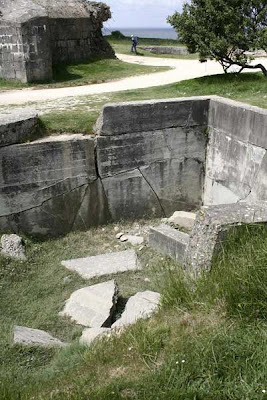Pointe du Hoc, Normandy
This is the first Tobruk Pit that you come across at the site. Please note the huge shell crater in front of this concrete fortification. Interestingly enough the Tobruk Pit is unaffected by the massive impact.

The site is gradually being reclaimed by nature. This is quite fitting in a way.
Note the massive internal damage of casemate from a direct hit.
One of the circular gun pits. The marks on the circumference of the pit are pre-arranged target sites/triangulation marks.
The original monument is now cordoned off, presumably due to coastal erosion.
A subterranean bunker exposed by an air-dropped bomb, the shattered parts of the roof of the casemate is evident at the floor of the structure. The occupants clearly had no escape on that fateful day.
La Pointe du Hoc...a shattered WWII German static naval gun battery site between the Omaha and Utah landing beaches, situated on a stunning promontory of coastal cliffscape that quite literally take your breath away even at the worst of times.
The site, which was donated to the American people by the French Republic in gratitude for the sacrifice made by the American forces on D-Day, is managed by the American Battle Monuments Commission and is extremely well presented. As with the main American Cemetery at Omaha Beach the facility is an impeccable and impressive destination.
This battery, situated on the Normandy coastline, was designated as an important strategic objective on the western aspect of Omaha Beach Sector on D-Day. The Germans had built this major coastal battery on a prominent geographical coastal feature that could threaten the American landing beaches; Omaha to the East and Utah to the West (each beach flanking the same estuary, which lies a few kilometres to the west of Pointe du Hoc). Having been delivered by amphibious assault craft on 06 June 1944, men of the 2nd Rangers Battalion assaulted this site from sea-level using ladders provided by the London Fire Brigade under heavy fire from the German defenders. Bomb-blasted, bullet-raked and shell-shot the Rangers heroically fought up the cliffs with daring, courage and bitter determination. Once atop the cliffs these brave combatants discovered a heavily bomb-damaged landscape and noted the conspicuous absence of the anticipated artillery guns in the huge steel reinforced concrete casemates and circular purpose-built pits, but they fought on for control of this prominent position. There is controversy about this site, which is heavily debated, most especially at the battery just up the road recently rediscovered by a British ex-pat and entrepreneur, but that, as they say...is another story. Personally, I feel that it is most appropriate to let this site speak for itself: a testament to the bravery of the attackers who fought for bitter survival on this precipitous objective until they were relieved long after the bulk of their fighting strength had been severely compromised by the German defenders’ weapons two days later. In my opinion this site and its cratered provenance stands as a memento to all the many brave men fought and died, not only on this site, but throughout the ETO before, during and after the fated D-Day, the 6th of June 1944 for the liberation of Europe from the yoke of Fascist tyranny.
The vista of the site proper; highly impressive and a little bit too much to take in all at once.
Evidence of the massive destruction wreaked on the site before D-Day by the RAF with powerful ordnance.
Some of the incredibly strong casemates still stand amidst the cratered landscape.
The final concrete fortification looks small and distanced from the main site, but is, in fact, a rabbit warren of an artillery emplacement, the bunkers of which are many feet deep in stagnant water.
After leaving the well-manicured and spotless car park you pass a visitors reception building, which is a visually attractive in design, you stroll on to some sobering bronze plaques in a semi-circle with topographic maps and some background to the site. You are still flanked by pristine horticulture and three very well manicured, if somewhat deep shell craters; the path has to divert around these to the main site where you are suddenly faced with a complete paradox...a scene of clear utter devastation, which is partially reclaimed by nature and to a certain extent managed by a team of dedicated groundsmen. Having visited many sites in Normandy during June 2008, we realised that this site had received a massive amount of ordnance, as not only were the casemates on this site some of the biggest, thickest and well constructed, but they were the ones that had received the most damage. Just looking at some of the bunkers sent a chill down the spine, thinking of those who had suffered the incredible amount of pulverising they sustained form air and naval bombardments to incapacitate the artillery sited there.
All that said, I think that the pictures tell the story best of all.
Bill Hazard



















Ahh the mameries.
ReplyDeleteRemember that one. Took Paul there last year, not such nice weather as when we were there
Shame; those pictures look super in the good weather, don't they?
ReplyDeleteI must say Stu; our trip was a whirlwind tour - we packed SOOO much in! I have literally hundreds of pictures.
Bill